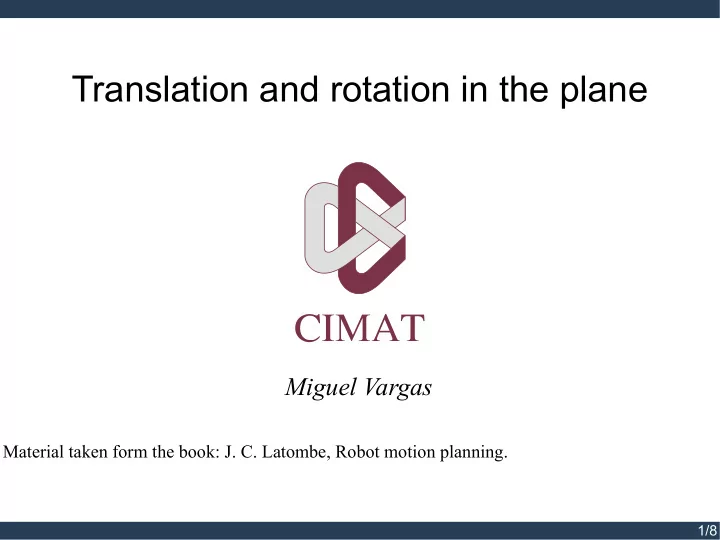

Translation and rotation in the plane Miguel Vargas Material taken form the book: J. C. Latombe, Robot motion planning. 1/8
The setup The setup 2 . The working space is W =ℝ The robot A is line segment of length d , with endpoints P and Q . The point P is located at ( x , y ) , the orientation is taken from an angle θ∈ [ 0,2 π ) . 1 , each configuration is ( x , y , θ ) . 2 × S Thus the configuration space C of A is ℝ The union of all obstacles form a polygonal region B . 2 × [ 0,2 π ) . CB is a three dimensional region in ℝ 2/8
Critical curves Critical curves These curves can be expresed with an algebraic formula. Obstacle edges are said to be critical curves of type 0 . a) The line segment at distance d from an obstacle edge E . This line has the same length as E . E is a critical curve of type 1 . b) and c) The arc of radius d , centered at the obstacle vertex X and bounded the two lines that form the vertex. X is a critical curve of type 2 . 3/8
Critical curves d) Let E be an obstacle edge and X a convex vertex at one endpoint of E . PQ is contained in the line containing E . The line traced as A slides and Q is in E is a critical curve of type 3 . e) X 1 and X 2 are two convecx obstacle vectices, A is bitangent to them. The line traced by P as A moves is a critical curve of type 4 . f) E is and obstacle edge, X is a convex obstacle vertex that is not and endpoint of E . The distance between E and X is h . If h < d , the curve traced by P , as A moves in a way such that it touches both E and X is a critical curve of type 5 . 4/8
Critical curves This curve is a conchoid of Nicodemes, with 2 + ( x + k ) 2 , 2 = ( y + h ) d y x = h k , thus 2 ( 2 − 1 ) . 2 d 2 = y x ( x + h ) The set of critical curves is finite. Every critical curve is a smooth curve algebraic curve of degree 1 (0, 1, 3, 4), 2 (2), or 4 (5). 5/8
Critical curves The configuration space will be divided using this critical curves using a connectivity graph G . G is an undirected graph, each node is a cell in C . Two nodes are connected if the cells that they represent are adjacents. A position ( x , y ) is admisible if there exists at least one orientation θ such that ( x , y , θ ) ∈ C free . A non-critical region R is defined in base of a contact of A with obstacles, it is defined as F ( x , y ) = { θ ∣ ( x , y , θ ) ∈ C free } . 6/8
Critical curves If A is free for all θ , then F ( x , y ) = [ 0, 2 π ) , else F ( x , y ) = a finite set of intervals For each maximally connected interval ( θ 1, θ 2 ) ⊆ F ( x , y ) , let s 1 and s 2 the contacts by A ( x , y , θ 1 ) and A ( x , y , θ 2 ) . The contacts could be on either a vertex X or an edge E . Each interval has associated two contacts, one is a clockwise (at θ c ) the other is counterclockwise (at θ ' c ). Let σ ( x , y ) be the set of all the pairs [ s ( x , y , θ c ) , s ( x , y , θ ' c ) ] , the interval ( θ c , θ ' c ) ⊆ F ( x , y ) . If F ( x , y ) = [ 0, 2 π ) , we write σ ( x , y ) = { [ Ω , Ω ] } . 7/8
Critical curves Given a pair [ s 1, s 2 ] ≠ [ Ω , Ω ] , we denote an unique orientation λ ( x , y , s 1 ) such that A ( x , y , λ ( x , y , s 1 ) ) touches the clockwise stop s 1 . Let R be a non-critical region. A cell is defined as cell ( R , s 1, s 2 ) = { ( x , y , θ ) ∣ ( x , y ) ∈ R ∧θ∈ ( λ ( x , y , s 1 ) , λ ( x , y , s 2 ) ) } . Two cells κ= cell ( R , s 1, s 2 ) and κ ' = cell ( R' , s' 1, s' 2 ) are adjacent if and only if: • The boundaries ∂ R and ∂ R' of R and R' share a critical curve section β , and • ∀ ( x , y ) ∈ int ( β ) : ( λ ( x , y , s 1 ) , λ ( x , y , s 2 ) ) ∩ ( λ ( x , y , s' 1 ) , λ ( x , y , s' 2 ) ) ≠∅ 8/8
Recommend
More recommend